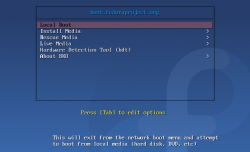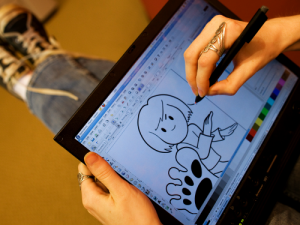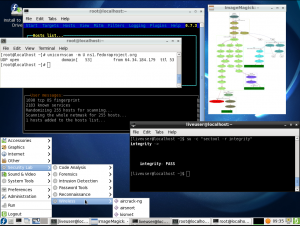
Fedora è un sistema operativo, basato su Linux, che consente al tuo PC, portatile o server di funzionare con il più recente software free e open source, mettendoti a diposizione centinaia di applicazioni sviluppate dalla community. Il sistema operativo Fedora, utile ed accessibile, è realizzato grazie al contributo di tante persone del globo che cooperano insieme: il Fedora Project.

|

|

|

|

|
Fedora è free (non ha bisogno di licenza) per l'uso: si può modificare, copiare e distribuire liberamente; e contiene tutto il software necessario per lavorare, giocare, comunicare ed altro ancora. Per conoscere le attività svolte dal Fedora Project, puoi dare un'occhiata alla Panoramica.

Quali sono le novità in Fedora 13?
Fedora 13 (Goddard) si è arricchito per rendere Linux ancora migliore, per tutte le tipologie di utenti. Ecco alcune novità che troverai in Fedoa 13.
Per gli Utenti Desktop
 |
Vuoi il 3D? We've got it, in completely free, accelerated video drivers for ATI, Intel, and now NVidia too. Out of the box you can run a variety of 3D accelerated games, enable cool desktop effects, and even try out the next-generation GNOME Shell on Intel and ATI cards. To set up the new bling for NVidia, just install the mesa-dri-drivers-experimental package using Fedora's handy PackageKit tool.
And since these drivers are completely free (as in cost and freedom), we can continue improving them like any other free and open source software so your enjoyment grows over time. |
Per gli Amministratori
If you spend your day managing how other people around you use Linux, Fedora 13 is loaded with features that will make your life even easier. Whether you want to migrate new users to a Linux environment or experiment with the newest in open-source technologies to give yourself an edge, Fedora has all the tools you need.
Per gli Sviluppatori
Sei un hackerCite error: Invalid <ref> tag; name cannot be a simple integer. Use a descriptive title, a cui interessa sapere come è realizzato il software open source? O, stai per per realizzare una grande applicazione web che stupirà il mondo? Bè, allora apprezzerai le novità per gli sviluppatori, presenti in Fedora 13.
| SystemTap ti offre già diverse modalità per monitorare il kernel, come sapere se stia leggendo dalla rete o scrivendo su disco. Ma con i nuovi static probe in Fedora 13, SystemTap può scovare al di là del kernel, permettendo di vedere cosa succede all'interno delle applicazioni e nel runtime di linuguaggi come Java, Python e TCL.
E come non ricordare gli avanzamenti in Python! Se sei un amante di Python come noi, noterai la capacità di Fedora 13 di generare backtrace per linguaggi misti. Il debug di codice misto, Python e C/C++ si, è notevolmente semplificato in Fedora 13, grazie allo sforzo compiuto in Fedora dai suoi progettisti. Inoltre Fedora 13 si fa pionere di uno stack Phyton 3, installabile in parallelo per consentire di realizzare e testare codice in entrambi gli ambienti, Python 2.6 e Python 3. |
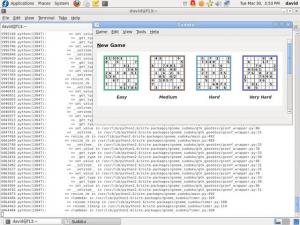 |
E se ti interessa Java, allora troverai la version 6.8 della NetBeans IDE, la prima ad offrire completo supporto all'intera Java EE 6 spec. Si è anche migliorato il supporto per JSF 2.0/Facelets, Java Persistence 2.0, ed EJB 3.1.
E naturalmente la collezione di pacchetti di Fedora, è ricca di centinaia di altri strumenti per molti linguaggi e stili di sviluppo. Del resto sono gli stessi strumenti che usiamo anche noi per questi nostri sviluppi.
Le Spin
Spins are more specialized versions of Fedora that allow you to run programs that suit your interests. For example:
Looking for something else?
Find more spins at http://spins.fedoraproject.org/ -- there's a spin for everyone, from education and gaming to science and more!
How to get started
Intrigued? Want to give Fedora 13 a try?
You can visit http://fedoraproject.org/get-fedora to download a LiveCD, regardless of what operating system you're running. This will give you a working version of Fedora, complete with common applications, all running off your CD drive - your hard drive won't be touched at all. And when you're ready, installation is just a click away.
Want an even more enjoyable way to use Fedora, risk-free? Try the Live USB option. You can use the same download to create a bootable USB stick so you can take Fedora with you anywhere you go. It works great with netbooks without CD drives, too. Check out the instruction page here:
http://fedoraproject.org/wiki/How_to_create_and_use_Live_USB
And if you're running Fedora 12, upgrading is easy. Refer to our handy documentation for help.
Aiutaci a migliorare Fedora!
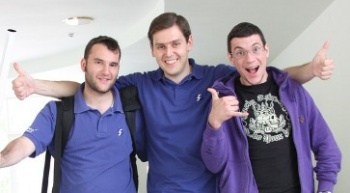 |
Want to join the Fedora community and help us make the best Linux distribution even better? Get started at http://fedoraproject.org/wiki/Join. Our diverse community from all over the globe welcomes contributors of all types. From artists to marketers to coders to testers to writers to translators and more, you too can get involved. Share what you know or help with something you've always wanted to learn; mentors are always available to help you get started. Any help is appreciated!
We'd love to hear your thoughts on Fedora 13. Have a suggestion? Find a bug? Start by taking a look at the Common F13 bugs to see if it's something we know about. (That page has information on what to do if you don't find your bug, too.) |
Ulteriori letture
Want more? Here are some further resources on Fedora 13, or talk with a community member in our live chat 24/7.
- Fedora 13 release announcement (http://fedoraproject.org/wiki/Fedora_13_Announcement)
- Fedora Overview (http://fedoraproject.org/wiki/Overview)
- Fedora FAQ (http://fedoraproject.org/wiki/FAQ)
- Help and Discussions (http://fedoraproject.org/wiki/Communicate)
- Fedora 13 release notes (http://docs.fedoraproject.org/en-US/Fedora/13/html/Release_Notes/)
- Fedora 13 feature profiles (http://fedoraproject.org/wiki/F13_feature_profiles)
- Fedora 13 talking points (http://fedoraproject.org/wiki/Fedora_13_Talking_Points)
- Common Fedora 13 Bugs (http://fedoraproject.org/wiki/Common_F13_bugs)
A proposito di questo documento
- PDF version of this document (Sources)
- Translations of this document are also available - if you make a translation, please link to it from this list!



